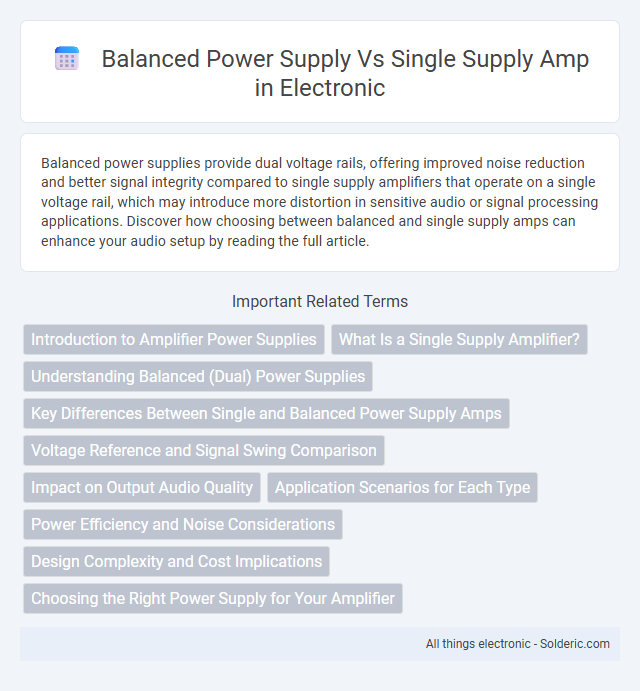Balanced power supplies provide dual voltage rails, offering improved noise reduction and better signal integrity compared to single supply amplifiers that operate on a single voltage rail, which may introduce more distortion in sensitive audio or signal processing applications. Discover how choosing between balanced and single supply amps can enhance your audio setup by reading the full article.
Comparison Table
| Feature | Balanced Power Supply | Single Supply Amplifier |
|---|---|---|
| Voltage Rails | Uses dual rails (positive and negative) | Uses a single positive voltage rail |
| Signal Handling | Supports bipolar signals, symmetric around zero | Handles signals referenced to ground (unipolar) |
| Output Swing | Wider output voltage swing due to dual supply | Limited output swing, constrained by single rail |
| Complexity | More complex power supply design | Simpler, minimal power supply required |
| Cost | Higher due to additional supply components | Lower cost and easier implementation |
| Usage | Ideal for analog circuits needing symmetrical voltages | Widely used in battery-powered and low-voltage systems |
| Noise Performance | Reduced noise and improved performance in balanced setups | May suffer from ground noise and offset issues |
Introduction to Amplifier Power Supplies
Balanced power supplies provide equal positive and negative voltage rails relative to ground, enhancing signal symmetry and reducing noise in amplifier circuits. Single supply amplifiers operate from a single positive voltage source referenced to ground, often requiring biasing techniques to achieve proper signal swing. Your choice between balanced and single supply amplifiers impacts performance factors such as distortion, noise levels, and circuit complexity.
What Is a Single Supply Amplifier?
A single supply amplifier operates using only one voltage source, typically referenced to ground, allowing it to amplify signals without the need for a negative voltage rail. This design simplifies power requirements and is commonly used in battery-powered and low-voltage applications. Single supply amplifiers require special input and output biasing techniques to handle signals that swing near ground level.
Understanding Balanced (Dual) Power Supplies
Balanced (dual) power supplies provide both positive and negative voltages relative to a common ground, enabling operational amplifiers to handle signals that swing above and below zero volts. This configuration enhances linearity and reduces distortion in audio and analog circuits by allowing the amplifier to operate symmetrically around zero volts. Your choice between balanced and single supply amps affects signal fidelity, especially in applications requiring precise amplification of AC signals.
Key Differences Between Single and Balanced Power Supply Amps
Balanced power supply amps use dual voltage rails (positive and negative) that deliver symmetrical power, reducing noise and distortion for cleaner audio output. Single supply amps operate with a single voltage rail and rely on offsetting techniques, often resulting in higher noise levels and less headroom compared to balanced configurations. Understanding these differences helps you choose the right amplifier for your audio system's fidelity and performance needs.
Voltage Reference and Signal Swing Comparison
Balanced power supplies provide a dual voltage reference, typically +-15V, allowing operational amplifiers to handle input and output signals that swing both positive and negative around a true ground potential. Single supply amplifiers rely on a single positive voltage source, often with a virtual ground or midpoint reference, limiting signal swing to between ground and the supply voltage, which can reduce the linear range and complicate signal processing. The balanced supply configuration enables greater signal headroom and lower distortion for AC signals by maximizing symmetrical voltage swing relative to ground, whereas single supply designs require careful biasing to maintain signal integrity within a constrained voltage range.
Impact on Output Audio Quality
A balanced power supply reduces noise and interference in amplifier circuits, leading to cleaner audio output and enhanced signal integrity compared to single supply amps. Single supply amplifiers can introduce more distortion and hum due to their reliance on asymmetric voltage rails, impacting dynamic range and clarity in your audio system. Choosing a balanced power design significantly improves the overall sound quality by providing a stable, noise-free power source for audio components.
Application Scenarios for Each Type
Balanced power supply amplifiers excel in professional audio equipment and communication systems where noise reduction and signal integrity are critical, such as in studio mixing consoles and high-fidelity audio interfaces. Single supply amplifiers are ideal for battery-powered devices, portable electronics, and simple sensor signal processing where circuit simplicity and low voltage operation are priorities. Choosing between the two depends on the noise environment and power constraints inherent to the application scenario.
Power Efficiency and Noise Considerations
Balanced power supplies generally offer improved noise rejection by providing symmetrical voltage rails that reduce common-mode noise, enhancing audio and sensitive signal integrity. Single supply amplifiers typically consume less power due to simpler circuitry but may require additional filtering to mitigate noise issues inherent in unipolar voltage designs. Efficiency in balanced power systems can be lower because of dual rail regulation and increased component count, whereas single supply amps often optimize power consumption for portable or low-power applications.
Design Complexity and Cost Implications
Balanced power supplies require more intricate circuitry with dual voltage rails, which increases design complexity and manufacturing costs compared to single supply amps. Single supply amplifiers simplify the design by operating from a single voltage source, reducing component count and lowering overall expenses. Your choice depends on whether the additional cost and complexity of balanced supplies justify the enhanced performance for your application.
Choosing the Right Power Supply for Your Amplifier
Choosing the right power supply for your amplifier significantly affects sound quality and performance. Balanced power supplies provide symmetrical voltage rails, reducing noise and improving signal integrity, while single supply amps use a single voltage rail, often requiring level shifting and potentially generating more noise. Understanding your amplifier's requirements and the environment in which it operates helps you determine whether a balanced or single supply design best matches your audio needs and ensures your system runs smoothly.
Balanced power supply vs Single supply amp Infographic

 solderic.com
solderic.com